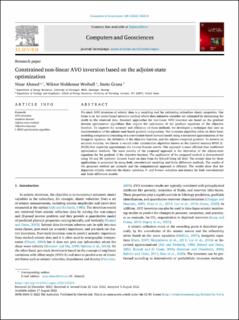| dc.contributor.author | Ahmed, Nisar | |
| dc.contributor.author | Weibull, Wiktor Waldemar | |
| dc.date.accessioned | 2023-02-17T13:06:58Z | |
| dc.date.available | 2023-02-17T13:06:58Z | |
| dc.date.created | 2022-08-30T21:39:34Z | |
| dc.date.issued | 2022 | |
| dc.identifier.citation | Ahmed, N., Weibull, W. W., & Grana, D. (2022). Constrained non-linear AVO inversion based on the adjoint-state optimization. Computers & Geosciences, 168, 105214. | en_US |
| dc.identifier.issn | 0098-3004 | |
| dc.identifier.uri | https://hdl.handle.net/11250/3051983 | |
| dc.description.abstract | Pre-stack AVO inversion of seismic data is a modeling tool for estimating subsurface elastic properties. Our focus is on the model-based inversion method where then unknown variables are estimated by minimizing the misfit to the observed data. Standard approaches for non-linear AVO inversion are based on the gradient descent optimization algorithms that require the calculation of the gradient equations of the objective function. To improve the accuracy and efficiency of these methods, we developed a technique that uses an implementation of the adjoint-state-based gradient computation. The inversion algorithm relies on three basic modeling components consisting of a convolution-based forward model using a linearized approximation of the Zoeppritz equation, the definition of the objective function, and the adjoint-computed gradient. To achieve an accurate solution, we choose a second-order optimization algorithm known as the Limited memory-BFGS (L-BFGS) that implicitly approximates the inverse Hessian matrix. This approach is more efficient than traditional optimization methods. The main novelty of the proposed approach is the derivation of the adjoint-state equations for the gradient of the objective function. The application of the proposed method is demonstrated using 1D and 2D synthetic datasets based on data from the Edvard Grieg oil field. The seismic data for these applications is generated by using both convolutional modeling and finite difference methods. The results of the proposed method are accurate and the computational approach is efficient. The results show that the algorithm reliably retrieves the elastic variables, P- and S-wave velocities and density for both convolutional and finite difference models. | en_US |
| dc.language.iso | eng | en_US |
| dc.publisher | Elsevier | en_US |
| dc.rights | Navngivelse 4.0 Internasjonal | * |
| dc.rights.uri | http://creativecommons.org/licenses/by/4.0/deed.no | * |
| dc.title | Constrained non-linear AVO inversion based on the adjoint-state optimization | en_US |
| dc.title.alternative | Constrained non-linear AVO inversion based on the adjoint-state optimization | en_US |
| dc.type | Peer reviewed | en_US |
| dc.type | Journal article | en_US |
| dc.description.version | publishedVersion | en_US |
| dc.rights.holder | The authors | en_US |
| dc.subject.nsi | VDP::Teknologi: 500 | en_US |
| dc.source.pagenumber | 16 | en_US |
| dc.source.volume | 168 | en_US |
| dc.source.journal | Computers & Geosciences | en_US |
| dc.source.issue | 11 | en_US |
| dc.identifier.doi | 10.1016/j.cageo.2022.105214 | |
| dc.identifier.cristin | 2047383 | |
| cristin.ispublished | true | |
| cristin.fulltext | original | |
| cristin.qualitycode | 1 | |

